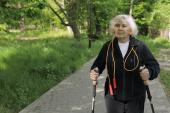Physical Activity Ebbs, Flows Over a Lifetime but Rarely Rebounds After CVD
Declines in moderate-to-vigorous exercise start in midlife, then speed up before diagnosis—raising opportunities to intervene.

Adults have steep declines in moderate-to-vigorous-intensity physical activity (MVPA) before developing CVD, and the reduction in exercise tends to persist after their diagnosis, data from the CARDIA study show.
The results, published online Wednesday in JAMA Cardiology, also revealed demographic differences—with Black women consistently seeing the lowest levels of physical activity over time and the greatest impact of CVD—that point to the potential for targeted strategies that promote exercise tailored to life stage.
“Understanding how physical activity evolves over time requires a life course perspective that considers changes in response to key events,” Yariv Gerber, PhD (Tel Aviv University, Israel, and the National Heart, Lung, and Blood Institute, Bethesda, MD), and colleagues say. “CVD may represent such a turning point, potentially leading to temporary or lasting behavioral change.”
Gerber told TCTMD in an email that the biggest surprise in the data was how few patients were able to bounce back after a CVD diagnosis.
“I expected to see a substantial increase in physical activity post-CVD, as a kind of ‘wake-up call,’ but that didn’t happen. The persistent gap between cases and controls—even years after the event—really stood out,” he said.
Healthcare practitioners “should continue to emphasize the importance of physical activity at every stage—not just for prevention, but especially after a CVD event. Even short discussions during routine visits can make a difference. Clinicians can help normalize physical activity as part of everyday life and recovery,” Geber advised.
Varying Trajectories
Using data from CARDIA, which studied CV risk in young adults, Gerber et al conducted a cohort analysis of 3,068 patients. Mean age was 25.2 years at baseline, and 56.8% of participants were female. Forty-four percent self-identified as Black and the rest as white.
Activity levels, based on participants’ answers to a validated questionnaire, were measured via exercise units (EU), with 300 EU equating to approximately 150 minutes/week of MVPA. Mean MVPA at baseline was 423 EU.
The researchers found that, overall, MVPA decreased between young adulthood and middle age before stabilizing thereafter. Black men initially had the highest activity level before being surpassed in their 40s by white men and in their 50s by white women. White men also had a decline in MVPA, but then they stabilized and even rebounded slightly. Black women had the lowest amount of MVPA across time. White women started out with a lower activity level than both Black and white men, but “showed a notable recovery beginning in midlife,” the paper reports.
In a nested case-control analysis of 236 incident CVD cases, the investigators matched each person to controls without CVD by age, sex, and race. Participants who developed CVD (defined as coronary heart disease, stroke, or heart failure) began getting less MVPA approximately 12 years before their illness, with the declines accelerating approximately 2 years prior. After CVD, patients continued to be less active than those who did not develop CVD.
By disease type, heart failure was associated with the steepest decline in MVPA, which then leveled off at 2 to 3 years before patients were diagnosed.
“Unlike heart attack or stroke, which are often sudden, heart failure tends to develop gradually,” Gerber explained. “People may experience fatigue or breathlessness for months or years before diagnosis, leading to a slow but steep decline in activity. The timing of diagnosis may lag behind the actual onset of the condition.”
Regardless of disease type, people with CVD were more likely than controls to have MVPA levels below 300 EU (OR 1.78; 95% CI 1.26-2.50). The greatest impact was seen in Black women (OR 4.52), followed by white women (OR 2.86) and Black men (OR 1.72).
Even short discussions during routine visits can make a difference. Clinicians can help normalize physical activity as part of everyday life and recovery. Yariv Gerber
Adulthood is a critical stage, Gerber said. “People often reduce activity gradually over time, and maintaining lifestyle changes in the long term is challenging. Life transitions—like parenting, changes in work, or weight gain—may contribute to this decline.” Additional risk factors have been shown by prior CARDIA analyses to be associated with steeper fitness declines, including smoking, body mass index, and socioeconomic decisions. Then, “after a CVD event, access to recovery support—like cardiac rehab—is uneven, which likely explains some of the persistent gaps we observed, especially across race and sex,” said Gerber.
Given the diversity in life experiences, culturally tailored strategies are key, Gerber advised. “This could mean programs that are community-based, affordable, and aligned with cultural values. Access to safe places for activity, transportation, and peer support also matters. Even brief counseling in clinical settings can help—if it’s consistent and meaningful.”
Future studies should dig deeper into why the activity patterns exist, include additional racial/ethnic groups, and rely on objective data to quantify exercise, he specified. “In addition, we need to examine the complex relationship between physical activity and obesity. There may be a feedback loop—where inactivity leads to weight gain, which then makes activity harder, especially after CVD. Untangling this relationship could help us design more effective, targeted interventions.”
Caitlin E. Cox is News Editor of TCTMD and Associate Director, Editorial Content at the Cardiovascular Research Foundation. She produces the…
Read Full BioSources
Gerber Y, Gabriel KP, Jacobs DR Jr, et al. Trajectories of physical activity before and after cardiovascular disease events in CARDIA participants. JAMA Cardiol. 2025;Epub ahead of print.
Disclosures
- The CARDIA study is conducted and supported by the US National Heart, Lung, and Blood Institute in collaboration with the University of Alabama at Birmingham, Northwestern University, the University of Minnesota, and the Kaiser Foundation Research Institute.
- Gerber reports no relevant conflicts of interest.





Comments